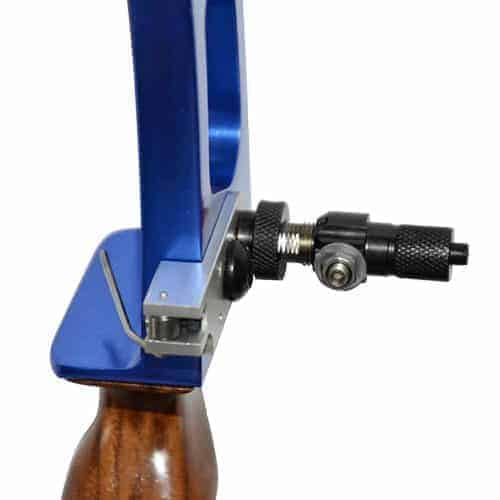Fact checked by Steven Lines, lifelong Hunter and Outdoorsman .
.
Suppose you are interested in Olympic or barebow archery. In that case, you need to know about an essential piece of kit known as a plunger button (aka a cushion plunger or cushion button).
A plunger is a necessary attachment for recurve bows, and you should get used to shooting with one from the moment you begin your archery adventure.
Everyone knows about bow risers, limbs, and strings, even if they don’t know the names of these parts of a bow’s anatomy. However, fewer people have heard of the plunger.
Given this piece of equipment’s essential yet unknown, you might wonder, “How does a plunger work on a recurve bow, and why do I need one?”
Plungers attach to your bow’s riser right above the arrow rest, and they absorb flex from the arrow upon its release. The absorption of flex helps the arrow to fly straight, increasing the accuracy of your shots.

It sounds pretty straightforward, but let’s dig a little deeper so you can fully understand how a plunger works and why you need one.
Most archers are familiar with the Archer’s Paradox. This deals with the same lateral flex of the arrow that we will look at when considering plungers and their use on recurve bows. Due to modern advancements in bow technology, the archer’s paradox is not relevant to most recurve shooters.
However, arrow flex is still relevant. We will discuss this more, but the first half of this short video will give you a good background understanding of arrow flex in recurve archery.
In this post, we'll cover:
Why Do Arrows Flex
If you watched the video above, you saw that arrow flex is still a significant consideration in modern archery. But why does this happen?
Arrows are not entirely rigid; they are designed to flex. With recurve bows, you use your fingers instead of a release mechanism to draw and release the string. The bowstring must slide around your fingers as you let go with your hand.
You will never be able to release fast enough to allow the string to travel in a straight line to its resting position. When the string glides around your fingers and back to the rest position, it transfers this lateral movement to the arrow.
There is another factor that contributes to the arrow bend. When you release the bowstring, more energy is put into the rear section of the arrow than the front. This energy differential causes the backend of the arrow to bend towards the front.
Each arrow will have two node points along the shaft around which the arrow bends, as shown in the video above. These two points do not move side-to-side, and the line that travels between them determines the path arrows flight path.
Both of the factors above contribute to the flex of an arrow in recurve archery. The flex from a recurve bow is along the horizontal plane, and you can adjust that line between the nodes by adjusting the amount of flex the arrow has along that lateral plane.
This is where the plunger comes in!
What is a Plunger & How Does it Work?
A plunger is a small device that looks similar to a spark plug and mounts onto the riser of your recurve bow.
A few primary components of a plunger allow you to set the horizontal position of your arrow on your bow’s arrow rest and help compensate for arrow flex.
Plunger Tip
The first component is the plunger tip; this is the small head of the plunger that goes through your bow’s riser. The tip is adjustable so that you can move it, either extending it farther out or closer into the riser across a lateral plane.
The arrow then butts up against the tip instead of the side of the riser. The adjustable action of the plunger tip allows you to change the lateral position of the arrow when it sits on your recurve’s arrow rest.
Plunger Spring
The second important piece of the plunger is the spring. Inside of the plunger, there is a spring with adjustable tension, usually via a dial. This spring acts as a sort of “shock absorber,” not unlike those on cars or mountain bikes.
If you press on the tip end of the plunger, you will notice that it pushes in and out, again along that lateral plane. As you release the bowstring, the arrow will flex against the tip, which goes against the spring.
This push allows the spring to absorb some of the flex from the arrow. How much flex is absorbed is determined by how much tension is in the spring. Remember that you can set this tension using the dial.
Why You Need a Plunger
A plunger allows you to set your center shot and compensate for the arrow’s flex. Setting the plunger up correctly to adjust both of these will improve the accuracy of your shot.
Let’s look at both of these uses in turn.
Setting your Center Shot
The center shot of the bow is the arrow’s lateral position on the bow. You want your arrow to be in line with the center of the bow so that it travels along a centerline that extends from your bow to the target.
The plunger tip can be adjusted to push the arrow left or right, as needed, so that the arrow is in line with the centerline of your bow when it is sitting on the arrow rest.
Generally, this is achieved by loosening the set screw in the adjustment collar and then spinning the adjustment collar until the plunger tip is in the correct position.
There is a lot of physics at play when shooting an arrow. Setting the center shot is not as easy as lining the arrow up with your bow’s midline. It might be best to enlist the aid of a shop pro or your coach for archery newbies to achieve an accurate center shot. Tools like the Beiter limb line gauge can set the center shot.
Flex Compensation
As we discussed, arrows flex upon release because the string must slip past your fingers and because of the difference in energy delivered to the front and back ends of the arrow.
Although archers strive for consistent releases, they are still human, and there will be minor differences in each release, even for the most experienced shooter.
There will be slight differences in your draw, determining how much energy you put into the arrow. There are also going to be small differences in how your fingers release the string. That spring, we mentioned earlier, is what will compensate for these differences.
You can adjust the spring’s tension by spinning the dial at the end opposite the plunger tip. This adjustment to the spring allows it to absorb more or less of that initial flex in the arrow to compensate for your release differences.
Plungers are a necessary piece of equipment for any archer looking to start into Olympic or barebow archery. They help to adjust the position of your arrow on the bow’s arrow rest. The spring inside also helps absorb some flex in the arrow as it is released from the bow.
Both of these plunger functions will help improve your shots’ accuracy.

Steven Lines is a hunter and outdoorsman from Safford, Arizona, USA. Since he was a child, he has been hunting and fishing and has over 20 years of outdoor experience. Steven works as a hunting guide in Arizona during his spare time and runs a Youtube channel dedicated to sharing his outdoor adventures with others.
dedicated to sharing his outdoor adventures with others.
